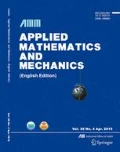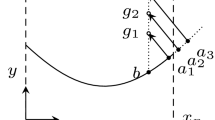Abstract
The flow field with a high order scheme is usually calculated so as to solve complex flow problems and describe the flow structure accurately. However, there are two problems, i.e., the reduced-order boundary is inevitable and the order of the scheme at the discontinuous shock wave contained in the flow field as the supersonic flow field is low. It is questionable whether the reduced-order boundary and the low-order scheme at the shock wave have an effect on the numerical solution and accuracy of the flow field inside. In this paper, according to the actual situation of the direct numerical simulation of the flow field, two model equations with the exact solutions are solved, which are steady and unsteady, respectively, to study the question with a high order scheme at the interior of the domain and the reduced-order method at the boundary and center of the domain. Comparing with the exact solutions, it is found that the effect of reduced-order exists and cannot be ignored. In addition, the other two model equations with the exact solutions, which are often used in fluid mechanics, are also studied with the same process for the reduced-order problem.
Similar content being viewed by others
References
Luo, J, Transition and prediction for hypersonic boundary layers. Transition and prediction for hypersonic boundary layers 36, 357–372 (2015)
Luo, J. S., Wang, X. J., and Zhou, H, Inherent mechanism of breakdown in laminar-turbulent transition. Inherent mechanism of breakdown in laminar-turbulent transition 48, 228–236 (2005)
Dong, M. and Luo, J. S, Mechanism of transition in a hypersonic sharp cone boundary layer with zero angle of attack. Mechanism of transition in a hypersonic sharp cone boundary layer with zero angle of attack 28(8), 1019–1028 (2007) DOI 10.1007/s10483-007-0804-2
Deng, X. G, High-order accurate dissipative weighted compact nonlinear schemes. High-order accurate dissipative weighted compact nonlinear schemes 45, 356–370 (2002)
Zheng, M. and Zhang, H, Application of non-oscillatory and non-free-parameters dissipative finite difference scheme to the calculation of free-jet flows. Application of non-oscillatory and non-free-parameters dissipative finite difference scheme to the calculation of free-jet flows 7, 273–281 (1989)
Shu, C. W. and Osher, S, Efficient implementation of essentially non-oscillatory shock-capturing schemes. Efficient implementation of essentially non-oscillatory shock-capturing schemes 77, 439–471 (1988)
Shu, C. W. and Osher, S. Efficient implementation of essentially non-oscillatory shock-capturing schemes, II.Journal of Computational Physics, 77, 32–78 (1989)
Liu, X. D., Osher, S., and Chan, T, Weighted essentially non-oscillatory schemes. Weighted essentially non-oscillatory schemes 115, 200–212 (1994)
Jiang, G. S. and Shu, C. W, Efficient implementation of weighted ENO schemes. Efficient implementation of weighted ENO schemes 126, 202–228 (1995)
Cockburn, B. and Shu, C. W. TVB Runge-Kutta local projection discontinuous Galerkin finite element method for conservation laws II: general framework. Mathematics of Computation, 52, 411–435 (1989)
Poinsot, T. J. and Lele, S. K, Boundary conditions for direct simulations of compressible viscous flows. Boundary conditions for direct simulations of compressible viscous flows 101, 104–129 (1992)
Tan, S. R. and Shu, C. W. A high order moving boundary treatment for compressible inviscid flows. Journal of Computational Physics, 230, 6023–6036 (2011)
Ferziger, J. H. and Peric, M. Computational Methods for Fluid Dynamics, Springer, New York, 39–63 (2002)
Author information
Authors and Affiliations
Corresponding author
Additional information
Project supported by the National Key Research and Development Project of China (No. 2016YFA0401200) and the National Natural Science Foundation of China (Nos.11672205 and 11332007)
Rights and permissions
About this article
Cite this article
Li, Y., Cao, W. Research of influence of reduced-order boundary on accuracy and solution of interior points. Appl. Math. Mech.-Engl. Ed. 38, 111–124 (2017). https://doi.org/10.1007/s10483-017-2153-6
Received:
Revised:
Published:
Issue Date:
DOI: https://doi.org/10.1007/s10483-017-2153-6




